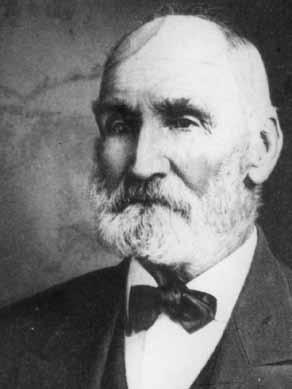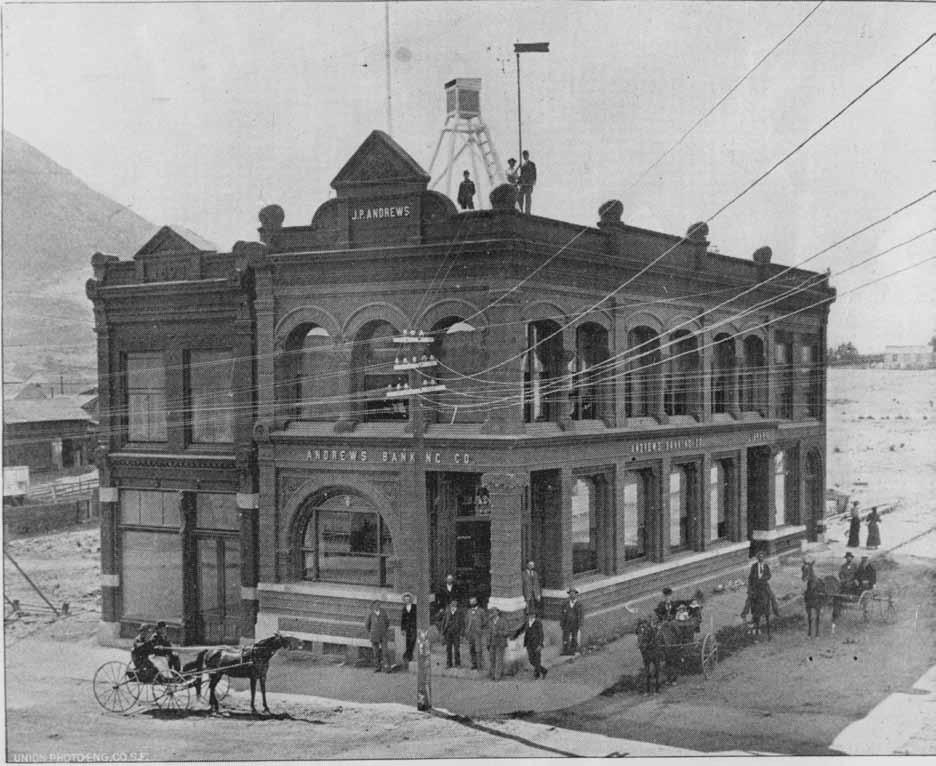
4 minute read
The Way It Was
J.P. andrews
The legacy of this complex, historical figure remains a mystery to this day.
BY KIMBeRLY TIMBS, exeCUTIve DIReCTOR, HISTORY CeNTeR Of SLO COUNTY
At the corner of Osos and Monterey streets stands a beautiful piece of architecture that is more than just retail space. The J.P. Andrews building at 998 Monterey Street in downtown San Luis Obispo is named for one of the savviest and perhaps most controversial businessmen known locally.
The ambitious and hot-tempered John Pinkney Andrews - known as “J.P.” to locals – originally hailed from North Carolina. Influenced by all the “glowing tales” of the riches to be found in California, he moved his family out West in 1857. After exploring the Golden Coast for a couple of years, they settled in San Luis Obispo in 1859. Andrews then wasted no time in getting his start raising dairy cows, sheep, pigs and bees (he was one of the first beekeepers in the county). It is believed that he made most of his money in just one year raising pigs as a result of a fatefully good decision.
During the drought of 1864, the lack of water crippled local ranches and left them unable to adequately feed their livestock. Unbelievably, there are stories of ranchers driving their cattle off cliffs into the ocean due to a lack of resources during this desperate time. However, Andrews did not panic. Instead, he bought up all the cows he could at rock-bottom prices – ranchers practically begged him to take them away. Andrews then processed the cattle and used them to feed his pigs, which he then sold at record-high prices. Although a bit grotesque, J.P.’s cold calculation in the face of widespread panic turned out to be incredibly profitable.
Andrews then parlayed a successful career in ranching into real estate and in 1883 he could be found at the head of the San Luis Hotel Company, which built the Andrews Hotel that was named in his honor. The building still stands today on the same spot. However, the structure you see now is not the original. The first hotel, which was constructed of wood, burned to the ground in April of 1886 after just a few months of operation.
Undaunted, Andrews rebuilt and re-opened his new building on January 2, 1894. As you can see today, the building was designed in the Richardson Romanesque style and features granite and terra cotta ornamentation and arches. The rebuilt structure was first used as a bank and the second story housed the City’s first public library. The new building was actually constructed in two phases between 1893 and 1906 eventually stretching the entire block between Monterey and Palm streets. The stonework and details are both grand and impressive.
While Andrews found plenty of good fortune in business, he was not so lucky in love. After 35 turbulent years of marriage, J.P.’s wife, Tennessee Andrews, filed for divorce on the grounds of “extreme cruelty.” Apparently, J.P. often left his wife and children alone on the
right andreWs bank, san luis obisPo rebuilt structure, circa 1894
below John Pinkney andreWs circa 1870

ranch to care for themselves and the animals. A harrowing account of a mountain lion attack told by one of his daughters concludes: “Snarling, the lion faced mother, who, taking as careful aim as she could under the terrifying circumstances, shot and killed the beast.”
The divorce case was heard by the County Superior Court. Divorce was extremely rare in those days - and almost never granted - the court would typically rule for a separation as an alternative. However, after hearing the testimony and calling witnesses, the court cited Andrew’s violent temper and felt that Tennessee would not be safe from J.P.’s reach in a separation. On february 7th, 1869 the court granted the divorce, a scandalous event in itself, which was surely the talk of the town for weeks if not months following.
To this day, opinions differ among local historians regarding J.P. Andrews. Some surmise that he was a kind philanthropist and a great businessman; others speculate that his success was due mostly to the misfortune of his fellow ranchers in the drought of 1864 and the hard work of his family and those he employed. Despite the controversy, what can be said for certain is that the J.P. Andrews building is an important part of our historic downtown and remains a true San Luis Obispo treasure to this day. SLO LIFE [ an account of the Andrews fire ]
“…the firemen responded promptly to the alarm with their apparatus, and vast crowds of people flocked to the scene. It needed but a glance to convince every beholder that the magnificent building was doomed. The fire had got such a head start and the vast building being constructed entirely of wood, to fight the flames seemed a hopeless task, but nothing daunted, our gallant firemen made a determined effort… When the fire had burned down to the second story, the heat became so great as to endanger surrounding buildings. …the heat was so intense that the men could stand it no longer, notwithstanding they were covered with wet blankets and streams of water were constantly thrown over them. The fight was a stubborn one, but the end of human endurance was finally reached and the men had to abandon the front of the buildings on Monterey Street.”

above andreWs hoTel, san luis obisPo devestated by fire only a few months after opening, circa April 1886 left Tennessee “Tinnie” andreWs wife of J.P. Andrews, with one of their children, circa 1900 - 1909
below andreWs building, san luis obisPo at the corner of Monterey Street and Osos Street, circa 1986











